by Mary Salinas | Jan 7, 2014
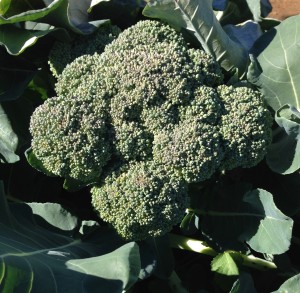
Broccoli, a popular winter vegetable. Photo by Mary Derrick, UF IFAS
In the Florida panhandle, we are fortunate to be able to grow crops throughout the year. The key is to know what to plant at the various times of the year.
Vegetables that can be planted now include beets, broccoli, cabbage, carrots, cauliflower, Chinese cabbage, collards, kale, kohlrabi, lettuce, green onions, English peas, radish and turnips. For those that are started from seed, especially carrots and radish, sow seed every 2 to 3 weeks to stagger the harvest.
During this cool time of the year, take stock of the vegetable garden area and decide if changes need to be made, such as moving or adding on to it. This is a good time of year to do the heavy labor before the warm, sweaty weather sets in. A popular choice is to add raised beds for growing herbs and vegetables. An advantage of a raised bed is that the garden starts with clean, rich soil that is weed and pest free. Grass and weeds do not have to be dug out for the garden; they can simply be covered by heavy groundcloth, newspaper or cardboard and the raised bed is placed on top.
[important]Consider getting a soil test if one has not been done within the past few years. Always get a soil test before adding lime – it will indicate if lime is needed and exactly how much to apply for best results. The cost is only $7 through the University of Florida. Contact the local Extension office for a soil test kit.[/important]
Stepping outside of the vegetable garden for a moment, for those interested in deciduous fruit such as peaches, pears and apples this is a great time to plant trees to give their roots time to develop before the warm, dry spring months. Be sure to select varieties that are proven performers for North Florida.
For further information please see:
Florida Vegetable Gardening Guide
Gardening in Raised Beds
Soil Sampling and Testing for the Home Landscape or Vegetable Garden
Deciduous Fruits for the Home Gardener in North Florida and North Central Florida
by Mary Salinas | Dec 24, 2013
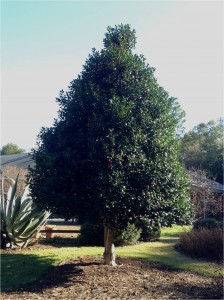
East Bay Holly. Photo by Mary Derrick, UF IFAS
[important]The best time to plant a tree was 20 years ago. The next best time is now. ~Chinese Proverb[/important]
In Florida, Arbor Day is always celebrated on the third Friday of January. In 2014, Arbor Day falls on Friday, January 17.
Consider planting a tree to enhance your property. Trees provide many benefits such as:
- Shade for leisure activities
- Lower energy costs for cooling
- Cover and food for wildlife
- Screen from unsightly views
- Privacy from neighbors
- Addition of value to your property; click here to determine the monetary value of a tree
If you have plenty of trees already, consider getting involved in a local community group that is sponsoring Arbor Day tree plantings. Or maybe your local church, park, non-profit or school would appreciate the donation and planting of a new tree.
So what trees are best to choose for the Florida panhandle? Some things to consider are soil type and pH, light, and any overhead obstructions. Click here for a publication that discusses what to consider when choosing a tree. Florida Trees for the Urban and Suburban Landscape will help you choose a particular tree species for your site. Considerations in tree selection may include bloom color and season, mature size, hurricane resistance, and whether it is evergreen or deciduous.
Once you have chosen a great tree for your specific site, proper installation and care is crucial to the success of your new tree. Click here to learn all about planting and caring for your tree.
For more information please see:
Arbor Day Foundation: Florida
Native Trees for North Florida
Palms for North Florida
Planting Trees in Landscapes
National Tree Benefit Calculator
by Taylor Vandiver | Dec 24, 2013

Garden Tools. Photo courtesy: UF/IFAS Gardening Solutions
Due to a lack of snow, Florida’s winter landscape chores are relatively uncomplicated. However, that doesn’t mean they’re unimportant. As the growing season comes to a close and gardeners mow, snip and spade for the final time, it’s time to consider proper cleaning and storage of all that equipment. A little preventative maintenance can avoid frustration and expensive repair in the future. When tools are maintained properly their life is extended substantially and their work efficiency is increased. A few examples of preventative care include cleaning and sanitizing, sharpening blades, and maintaining power equipment.
When cleaning tools, remove caked on soil or vegetation using a wire brush, scraper or a strong stream of water. Sharpen hoes, pruners, loppers and saws.
Always remember to check tools thoroughly for loose screws or nuts and tighten them accordingly. Spraying the bare metal parts and cutting edges of tools with a penetrating oil, such as WD-40, will help prevent rust. It is thought that wiping tools’ wooden handles with boiled linseed oil will help prevent wood from cracking and drying.
Another item to consider while preparing one’s landscape for the winter is the garden hose. While hoses don’t need a great deal of care, a few small steps are important if they are to last. Store hoses on hose supports or reels or coil them loosely rather than hanging them on nails. Using hose supports or reels prevents the hose from sagging and kinking. Drain all the water and store in a dry location before storing hoses away for the winter.
Power equipment, such as lawn mowers, may require additional winter preparations. Always refer to the owner’s manual for specific information. However, in general, the following steps can be taken to winterize this equipment.
Remove collected grease, dirt and plant material from the equipment. It is always beneficial to check for loose screws and nuts and tighten them accordingly. Remember to sharpen cutting edges. If equipment has a four-cycle engine, change the oil by following instructions listed in the owner’s manual. Remove all gasoline from tank. It’s good to run the engine a turn or two to coat the cylinder walls with oil, and then replace the plug.
Two-cycle engines, or engines that run with a gas and oil mixture, also should have the oil-gas mixture removed for the winter. Run the engine with the choke open to remove fuel from the lines. Check the spark plug and replace if it is worn. Replace other worn or damaged parts as well. Always avoid storing gasoline over the winter. Old gasoline does not ignite easily, making the machines using it work harder.
Once the cold weather creeps in to Florida, gardeners may feel as if they can sit back and wait for spring, however, don’t neglect proper maintenance of garden tools. When the weather warms up, properly working garden equipment will be the gardens’ best asset!
For more information feel free to contact your local Extension Office.
by Julie McConnell | Dec 9, 2013
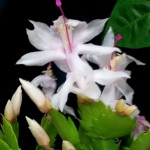
Photo credit: Julie McConnell, UF/IFAS
If you are looking for an easy to grow, colorful indoor flowering plant, look no further than Holiday Cactus. The two main types are Thanksgiving Cactus and Christmas Cactus which have similar care requirements but as the name indicates, bloom at different times.
When purchasing a new plant, don’t assume that it is “Thanksgiving” or “Christmas” based on when it was blooming at the store, growers know how to manipulate plants for flowering based on market demand. Instead look at the leaf shape and anther colors for positive identification. Thanksgiving cacti have pointed teeth on leaf margins and yellow anthers in the flowers. Christmas cacti have flattened leaves with rounded teeth on the margins and purple anthers.
The best spot for your Holiday cactus is a bright location away from any drafts or heating and cooling vents. Keep soil slightly moist, but take care not to over water. They can tolerate some drying out, but too much can cause flower buds to drop. In Northwest Florida’s mild climate you may keep your Holiday Cactus outside most of the year, but protect it from full sun during the summer months and bring it indoors if temperatures are forecast to fall below 50° F.
Fertilize Holiday cacti with a general purpose houseplant fertilizer from April until August following label directions. To make your plants fuller, prune or pinch in June and this will encourage more branching. Holiday cacti are easy to propagate. Take those pieces you pinched off and place in a lightweight potting soil or vermiculite and they will grow roots and you will have new plants to share.
So, how do you control flowering time? Holiday cacti form flower buds based on two environmental factors, photoperiod (length of daylight) and temperature. They are considered “short day” plants which mean that they bloom when light is reduced to 8-10 hours a day, but this description can be a little misleading. The true influencing factor is not the number of daylight hours, but rather the number of hours in uninterrupted darkness. One way to initiate flower bud development is to place the plant in a dark closet from 5 p.m. until 8 a.m. for 20-25 days straight. This treatment will stimulate flower bud development. Another factor that influences flower bud initiation (even without light control) is the temperature at night. The ideal night temperature for flower bud formation is between 55 and 68° F. Temperatures above 68° and below 50° F can prevent flower bud development.
To learn more about caring for your Holiday Cactus visit the following link Thanksgiving & Christmas Cacti Clemson Cooperative Extension HGIC1554.
by Matthew Orwat | Dec 9, 2013
Looking for the perfect Christmas tree to celebrate your Holidays? Join Wendy Wilber, UF/IFAS Extension Alachua County Environmental Horticultural Agent, as she offers tips on finding and preserving your fresh-cut Christmas tree throughout the Holiday Season.
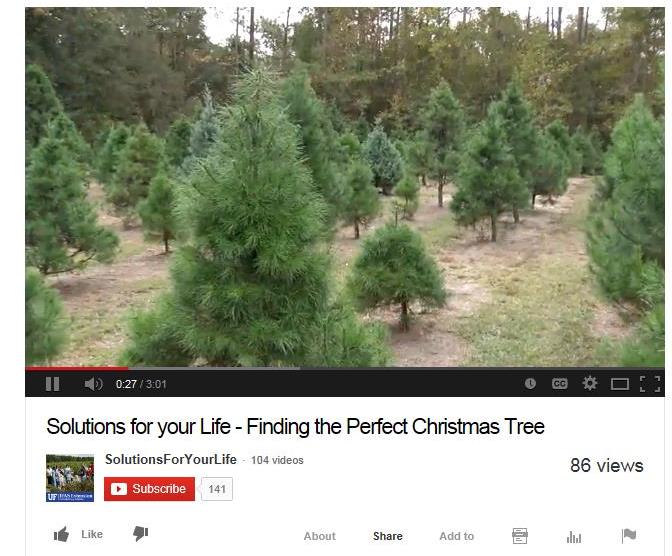
by Mary Salinas | Nov 25, 2013
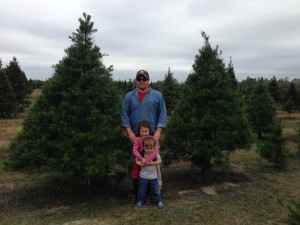
Whispering Pines Farm in Milton with proprietor Mike Kelly and children. Photo by Mary Derrick, UF IFAS.
One of the joys of this season is to bring home a fresh Christmas tree and enjoy the fragrance and natural freshness of a live tree inside your own home. Imagine how much fresher the tree would be if you harvested it!
The good news is there are Christmas tree farms in Northwest Florida where customers can choose and harvest their own Christmas tree! Visit the Florida Christmas Tree Association online to find the closest local Christmas tree farm. The website also offers information on tree varieties and how to care for harvested trees.
[notice] Here is a way to support your local farmer![/notice]
The varieties of trees grown in the panhandle are different from the northern trees brought south for the season. Christmas tree farms in the panhandle offer varieties such as Virginia pine, Leyland cypress, red cedar, Arizona cypress, Carolina sapphire, and Thuja “Green Giant’. Since these varieties do not grow naturally into the conical shape like northern-grown Christmas trees, the farmers take great care to train their trees into the traditional Christmas tree shape. Pruning and shaping the trees begins when they are about 2 years old and continues twice a year for as long as they are growing. The result is a tree that looks naturally shaped and ready for the tree stand.
Real Christmas trees are environmentally friendly as they are a renewable resource. Once trees are cut down, new ones are planted in their place. The trees are also reusable as mulch when chipped on-site or through county yard waste disposal services.
For additional information please see:
Christmas Trees and Their Care
Florida Christmas Tree Association






